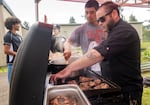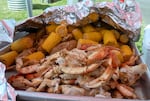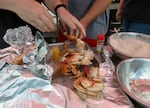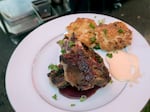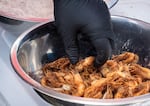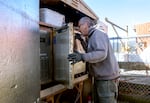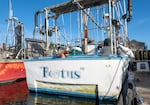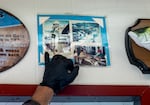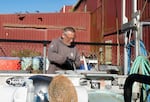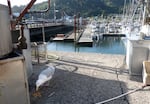
Siletz Valley School students Landynn Larson, left, Dean Smith, right, , and Zion Fantroy, back, splitting Dungeness crabs, May 23, 2024. Fantroy says he likes the seafood class, he especially likes that he gets to cook with his friends and try out different foods.
Alejandro Figueroa / OPB
Patrick Clarke is outside, setting up a big pot of broth with Cajun spices over a propane flame. He’s already got a grill running and has set out the corn, potatoes, sausage and pink shrimp.
He leans down to a chest cooler filled with ice and pulls out a live Dungeness crab.
“This is the money maker right here on the Oregon coast,” he says. “The crab fishery is probably the most valuable fishery that we have in Oregon. It’s a billion-dollar industry. And a lot of it comes straight into Newport right down the road here.”
Clarke is the culinary director at Siletz Valley School — a K-12 charter school serving the Siletz Indian Reservation about a 20-minute drive outside Newport — and teaches a handful of cooking courses there. His school is one of six coastal high schools participating in a pilot seafood butchery program that launched in April with the intent to teach students how to clean and cut all sorts of fish and crustaceans found on the Oregon coast. They also learn how to cook seafood, and, perhaps more significantly, they learn about its relationship to communities up and down the coast.
Clarke, a nearly 20-year veteran of the restaurant industry, said filleting is a dying art around the coast and much of the Pacific Northwest.
“You could run into a bunch of these high-end restaurants, I bet you six out of 10, if you ask one of their head chefs to fillet a salmon and pin bone it, he would get very nervous at that point,” he says. “Because they don’t do it anymore.”
The coastal seafood butchery program also serves a broader economic purpose: to bolster the seafood workforce as industry groups look to keep more Oregon-caught fish local. But first, the hands-on part. On the menu for the day: gumbo, with crab boil and shrimp cakes and a side of lamb chops.
Clarke puts two students in charge of grilling the sausages and the lamb chops. Another small group joins him to split the crabs and boil the legs. They begin doing it carefully by hand and discarding the guts into a trash bin.
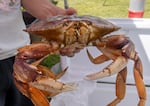
Dean Smith, a junior at Siletz Valley School, holds a live Dungeness crab, May 23, 2024. The crustacean is one of the most prized crabs across the Pacific Northwest.
Alejandro Figueroa / OPB
Dean Smith, a junior, says it was easy to get the hang of it.
“I pretty much understand it, all I needed was to see it one time,” he says. “I just wanted to take this class so I could learn how to cook for myself when I’m older.”
Another student, Landynn Larson, a sophomore, points out an easier way to do it. He grabs one of the crabs firmly by the legs and with one single motion jabs the head of the crab against the edge of a metal table, cleanly separating the head from the legs.
“There you go, you take his whole head off. That was pretty good. I’ve never done it that way,” Clarke says, praising Larson.
Larson says he learned that from his grandfather, who’s taught him how to clean and cut fish and to hunt. Larson plans to go to college to study architecture, but can see himself working at the docks and restaurants filleting fish.
“I can get a degree for that and work around here cutting up fish and cooking and all that for boats and for people, businesses,” Larson says. “That’d be a cool job to have, kind of a back up plan.”
Clarke says it’s hard to come by skilled filleters. That’s partly because it’s more cost-efficient for restaurants to order portioned fish rather than paying someone to clean and cut it. Plus many of the seafood processing plants along the coast have shut down or consolidated over the years. Most of them are now concentrated around Newport and Astoria in the north and Charleston on the southern coast.
Bolstering the coastal economy
The Oregon coastline spans over 300 miles, and it’s bountiful with fish like lingcod, rockfish, Chinook salmon and Dungeness crabs.
But 90% of the seafood sold and consumed on the Oregon coast is imported from domestic or international markets while most of what’s caught is exported. Yet locally, there’s a growing demand for more fish and crab caught on the Oregon coast, according to Maggie Michaels, the lead for the High School Seafood Butchery program for the Oregon Ocean Cluster Initiative — a group supporting efforts to keep more local seafood.
“Schools want more of it, institutions want more of it. People going to the grocery stores want more of it,” Michaels says.
Oregon’s “blue economy” — the sustainable use of ocean resources for economic growth — is driven by its commercial fishing industry. Much of it is also supported by tourism. According to the Oregon Ocean Cluster Initiative’s latest figures, visitors to the Oregon coast spend about $800 million on seafood and other food services per year, though much of that money isn’t spent on locally caught seafood.
Michaels says the group is looking to change that, and as more people ask where their seafood is coming from, communities need a workforce that matches that pent-up demand.
“We’re going to need more people to fillet because across the continuum of the seafood industry and seafaring industry we have a graying out,” Michaels says. “The folks who have these skills are getting older.”

Kelly Barnett cleans and organizes equipment in his trawler boat after a day of fishing off the coast in Garibaldi, Ore., May 23, 2024. Barnett is a fishmonger on the Oregon coast that catches, fillets and sell fish to local customers and visitors.
Alejandro Figueroa / OPB
Kelly “the Blade” Barnett knows just how valuable those skills are.
“You need somebody who can get all the meat off the fish because you don’t wanna waste it. That fish has sacrificed himself for us to eat. And to waste it is a crime,” he says.
Barnett is a fishmonger, he also catches his own fish and sells it at his market, the Spot, at the Port of Garibaldi.
After a day of fishing, he’s getting caught up on cleaning and smoking a batch of salmon ahead of Memorial Day weekend. He’s been filleting fish for nearly four decades. As for his nickname, he says there was a charter boat operator several years ago that used to put on a P.T. Barnum voice to introduce him whenever he showed up.
“Ladies and gentlemen, boys and girls, children of all ages, Siggi-G charters proudly presents Kelly ‘the Blade,’” he says. “And that name stuck.”
He’s seen things change.
“There was a fish plant at the end of the road here. And there were 12 to 20 skilled filleters there that worked full-time. And they would lend their talents to cutting the sports people’s fish,” he says. “And now there’s maybe two or three of us that do it commercially [in Garibaldi].”
He remembers when the filleters in training at the now-closed plants used to practice on the fish that were too small to be commercially viable.
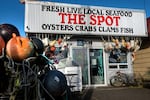
The Spot in Garibaldi, Ore., May 23,2024. The market, owned by Kelly "The Blade" Barnett, is one of a handful of places up were locals and visitors can buy Oregon-caught fish and crab.
Alejandro Figueroa / OPB
“Then we would take that — you know, 10 to 12 of us — up to the bar and give it to the bartender,” he says. “They would cook it up in their fish fryer and serve it to everybody in the bar. And so everybody enjoyed.”
He says what’s lost when the talent disappears from the coast is a sense of community and the ability to prepare and share a meal with someone. But he doesn’t let that keep him down. He’s helped train some of the high schoolers in the butchery program and sees similar efforts as a continuation of his community.
“They genuinely want that knowledge,” he says. “They made me feel really good that I had a skill to share that not everybody’s gonna get, but once you get it, you’ve got it for life.”
Back at Siletz, students are done boiling the crab legs and grilling the lamb chops, and are lining up for a plate. Students and teachers from other classes are queuing up for a bite too.
Some distance away, Clarke looks back and says seeing his students sharing the food they’ve made is one of the moments he most looks forward to.
“I don’t know how important, just that scene right there is,” he says.
He knows not all high schoolers will want to go into seafood. But at least they’ve done it and they learned something.
“[Cooking] is a gigantic part of life. It’s relaxing. It’s fun to do. You can impress dates with it,” he says. ”You create social dynamics by just sitting at the dinner table and having everybody sit down and share a meal.”
He knows how uncertain life can be as a teenager, and maybe, he says, he’ll run into an old face down the line.
“I hope I have students that come back and maybe they’ll get a James Beard nomination,” he says. “Or maybe I’ll just see them 10 years down the road and they’ll be like, ‘Pat, I’m cooking, I’m a chef now,’ and I’ll be like, ‘What? No kidding.’”

